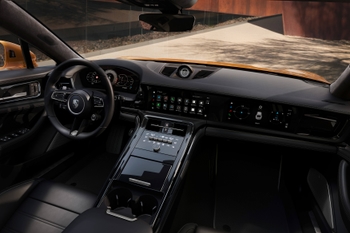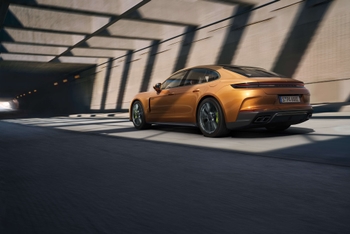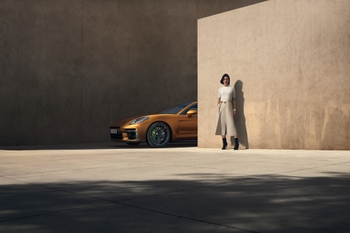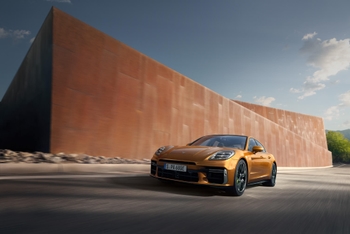
Porsche introduces the new Panamera: the third generation of the luxury sports sedan is distinguished by an expanded digital equipment, a fresh and expressive design, and a greater gap between the comfort and sportiness of driving modes. With enhanced performance of the E-Hybrid powertrains and its new high-end suspension, the Panamera sets new standards for sportiness in its class.

The Panamera lineup features a range of enhanced E-Hybrid engines, offering increased power, extended range, and optimized efficiency. Porsche's optional Active Ride Suspension, available with the Turbo E-Hybrid variant, ensures superior comfort and exceptional driving dynamics.
The Porsche Driver Experience interior concept strikes a perfect balance between analog and digital controls, orienting essential contact points and functions towards the driver. In line with this principle, the gear selector is positioned to the right of the steering wheel. The mode switch, which includes Normal, Sport, and Sport+ driving programs, and the driver assistance system toggle switch are directly within the driver's reach.
An optional 10.9-inch screen for the front passenger can display vehicle performance data and allows for the use of the infotainment system and even streaming video while driving. To eliminate distractions, the passenger's screen is not visible from the driver's seat.

- Porsche Active Ride suspension for greater comfort and dynamics
- Improved E-Performance – more power, more range
- New exterior design with even greater emphasis on width
- Porsche Driver Experience: new control concept and digital cockpit
- Extensive selection of innovative assistance systems
Porsche revamps the Panamera: the third generation of the sporting luxury sedan is characterised by a wider range of digital features, a fresh and expressive design and a broader spectrum between dynamic performance and driving comfort. More powerful E-Hybrid powertrains and a new high-specification suspension system underline the claim to offer the most dynamic sedan in the segment.
Stuttgart. The Porsche Panamera is entering its third model generation. The sports car manufacturer's luxury sedan emphasises its sporting character with even more powerful drive systems. The profile is enhanced by a fundamentally modernised operating concept and plenty of innovative technology. These include the new Porsche Active Ride suspension system, which combines a significantly higher level of comfort with the sporting driving characteristics for which Porsche is famous. The integration of the user’s own digital ecosystem into the Porsche Communication Management (PCM) offers new ways of interacting with the car. The technical yet elegant, dynamic design of the new Panamera gives the model line’s attractive proportions a fresh update. A wide range of driver assistance systems and a fundamentally redesigned, driver-centred interior enhance the driving experience.
Superior feel with state-of-the-art suspension systems
The new Panamera already comes with dual-chamber two-valve air suspension with Porsche Active Suspension Management (PASM) as standard. The two-valve technology separates the rebound and compression stages of the damper control and therefore offers an even wider range between comfort and sportiness: the system noticeably dampens impacts from transverse joints and road damage while at the same time ensuring more body stability in dynamic driving situations. The car’s handling can be further improved thanks to optional all-wheel steering.
In addition, the innovative Porsche Active Ride active suspension system is available as an option for the E-Hybrid models of the new Panamera. This system surpasses other suspension concepts in all relevant parameters and offers an unprecedented range between driving comfort and driving dynamics. The basis for this is newly developed active shock absorbers – also with two-valve technology – each connected to an electrically operated hydraulic pump. This generates a volume flow in the damper according to demand and can therefore build up forces between the body and wheels in a lightning-fast, highly precise and targeted manner, which counteract and almost completely compensate for the forces resulting from the road excitation. A weight-saving single-chamber air-suspension system complements this technology.
The chassis keeps the body of the Panamera flat at all times, even during dynamic braking, steering and acceleration manoeuvres. With a smooth ride, the system absorbs bumps almost completely. In dynamic driving situations, the Porsche Active Ride suspension system ensures a perfect connection to the road thanks to a balanced distribution of wheel loads.
If the corresponding mode is activated, the suspension can overcompensate for pitching and rolling tendencies to reduce the acceleration forces acting on the occupants. In this setting, the new Panamera leans into the corners like a motorcycle would. It pulls the front down when accelerating and the rear when decelerating. When stationary, the Porsche Active Ride suspension system lifts the body to a comfortable entry or exit height.
More E-Performance and comprehensively revamped engines
Porsche offers a total of four efficient E-Hybrid powertrains for the new Panamera, in response to the high demand for this type of drive system. All E-Hybrid variants benefit from greater performance, range and efficiency. The Panamera Turbo E-Hybrid is ready at market launch. The heart of its powertrain is a fundamentally revised four-litre V8 turbo engine. The output of the newly developed electric motor is 140 kW (190 PS). Together, they create a system output of 500 kW (680 PS). The system torque reaches an impressive 930 Nm. Porsche integrates the electric motor into the housing of the comprehensively redesigned eight-speed PDK dual-clutch transmission. Dispensing with a separate E-motor housing saves around five kilograms. The integration of the unit into the oil circuit of the transmission also optimises the heat balance of the electric drive unit and allows higher continuous output from the electric motor.
The Panamera Turbo E-Hybrid sprints to 100 km/h in 3.2 seconds and boasts a top speed of 315 km/h. Its battery capacity is now 25.9 kWh. This enables an equivalent electric range of up to 91 kilometres in the combined WLTP cycle or 83–93 km in the city cycle. A new 11 kW on-board AC charger shortens the charging time at suitable charging points to 2 hours and 39 minutes.
The Panamera and Panamera 4 variants will also be available at the time of the launch. Modifications to boost pressure, fuel injection flow rate and ignition timing optimise the performance of the 2.9-litre V6 turbo engine. It now generates 260 kW (353 PS) and 500 Nm of torque – an increase of 17 kW (23 PS) and 50 Nm compared to its predecessor. This shortens the Panamera’s sprint to 100 km/h to 5.2 seconds and boosts its top speed to 272 km/h. The all-wheel drive Panamera 4 now takes 4.8 seconds and reaches 270 km/h.
Luxurious and sporting inside and out
The new Panamera retains the characteristic lines and proportions of the model line. It measures 5,052 mm in length (Executive: 5,202 mm) and is 1,937 mm wide and 1,423 mm high (Executive: 1,428 mm). Its fundamentally revamped appearance lends the sports sedan an even more expressive and sporting look. Up front, an additional air intake above the number plate compensates for the increased air requirement of the drive systems. The redesigned window line in the sideview reinforces the sedan character of the four-door sports car. The outer edges of the rear window are flush with the contour of the body, creating harmonious lines at the rear of the car.
The Porsche Driver Experience cockpit concept features the ideal balance between digital and analogue control elements and positions the input and output elements essential for driving along the driver’s axis. The gear selector lever is directly to the right of the steering wheel. The mode switch for the Normal, Sport and Sport Plus driving programmes and the assistance control stalks are also directly accessible to the driver. This means that they don’t need to take their eyes off the road in order to adjust the drive programmes and assistance systems.
An optional passenger display closely integrates the passenger into the driving experience. The 10.9-inch screen displays vehicle performance data on request. It also allows operation of the infotainment system and supports video streaming while the car is in motion. In order to avoid distracting whomever is behind the wheel, the passenger display cannot be seen from the driver’s seat.
A more distinctive Panamera Turbo E-Hybrid
Model variants bearing the Turbo name enjoy a special position at Porsche as the performance flagships. Porsche has strengthened this position in the model line with the Panamera Turbo E-Hybrid. Externally, it is characterised by a distinctive rear apron with painted diffuser panels and a unique front apron in body colour. There are also chrome-plated tailpipes in dark bronze and optional centre-lock wheels, which can also be specified on the other models.
The Turbo-exclusive colour Turbonite is used as a contrast on the side window strips and the Turbo logo on the tailgate, as well as in the Porsche crest on the bonnet, wheels and steering wheel. Inside, Turbonite is combined with carbon elements to create a sporting ambience. It can be found, for example, in the central rev-counter in the instrument cluster and as the colour of the controls in the centre console.
Digital experience and new assistance systems
The new Panamera will become an integral part of the driver’s digital ecosystem. To log in with their personal Porsche ID, all customers need to do is scan a QR code displayed in the PCM with their smartphone. Apple CarPlay® and Android Auto enable the linking of smartphone and vehicle data for improved usability. The integration of vehicle functions from the MyPorsche app into Apple CarPlay® enables optimised operation of digital functions and creates a clearer overview. Functions such as air conditioning, seat massage and ambient lighting can be controlled directly via Apple CarPlay® or with the Siri® voice assistant.
Porsche is also equipping the Panamera with standard Matrix LED headlights. The high-resolution HD Matrix LED lighting system, which has more than 32,000 pixels per headlight, is available as an option. It offers completely new lighting features, such as dedicated lane brightening. The illumination range is up to 600 metres. Porsche has significantly upgraded the range of assistance systems in the new Panamera. The standard active speed assistant now interacts with traffic sign recognition. If the system is active, the Panamera will not automatically drive faster than the appropriate speed limit. Porsche InnoDrive including adaptive cruise control features active lane guidance and junction assist. A swerve assistant is now also part of the range of functions. Also new is that, during automatic parking, the driver no longer has to be in the car, although they are still responsible for the manoeuvre. The parking process can be monitored from a smartphone with the new Remote ParkAssist function.
Gallery











